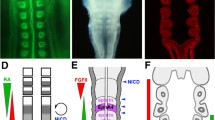Abstract
In many organisms, a reliable number of segments is produced even though important properties of the region involved, especially its size at the time of pattern formation, are apparently not specified with sufficient precision. We show that this can be readily accomplished if segmentation occurs through a sequence of bifurcations rather than all at once, and we provide evidence from developmental studies that indicates that this is typically what actually occurs. Our results strongly suggest that where patterns are formed reliably, this generally happens in stages rather than by the setting up in advance of a complete prepattern.
Similar content being viewed by others
References
Akam, M. 1987. The molecular basis for metameric pattern in theDrosophila embryo.Development 101, 1–22.
Arcuri, P. and J. D. Murray. 1986. Pattern sensitivity to boundary and initial conditions in reaction-diffusion models.J. math. Biol. 24, 141–165.
Carr, J. N. and P. H. Taghert. 1989. Pair-rule expression of a cell surface molecule during gastrulation of the moth embryo.Development 107, 143–151.
Coulter, D. and E. Wieschaus. 1987. Segmentation genes and the distributions of transcripts. News and views.Nature 321, 472–474.
Davidson, D. 1983. The mechanism of feather pattern development in the chick. I. The time of determination of feather position. II. Control of the sequence of pattern formation.J. Embryol. exp. Morph. 74, 245–273.
Fleig, R. and K. Sander 1986. Embryogenesis of the honeybeeApis mellifera L. (Hymenoptera: Apidae): an SEM study.Int. J. Insect Morphol. Embryol. 15, 449–462.
Gambles, P. 1985. Outlines of the distant past.Nature 314, 430–404.
Goodwin, B. C. 1984. A relational or field theory of reproduction and its evolutionary implications. InBeyond Neo-Darwinism: An Introduction to the New Evolutionary Paradigm, M. W. Ho and P. T. Saunders (Eds), pp. 219–241. London: Academic Press.
Goodwin, B. C. and S. A. Kauffman. 1990. Spatial harmonics and pattern specification in earlyDrosophila development. Part I: Bifurcation sequences and gene expression.J. theor. Biol. 144, 303.
Gould, S. J. 1990.Wonderful Life. New York: W. W. Norton.
Ho, M. W. 1984. Heredity and evolution. InBeyond neo-Darwinism: Introduction to the New Evolutionary Paradigm, M. W. Ho and P. T. Saunders (Eds), pp. 267–289. London: Academic Press.
Ho, M. W. 1990. An exercise in rational taxonomy.J. theor. Biol. 147, 43–57.
Ho, M. W., A. Matheson, P. T. Saunders, B. C. Goodwin and A. Smallcombe. 1987. Ether-induced disturbances in segmentation inDrosophila melanogaster.Roux Arch. Devl. Biol. 196, 511–521.
Ho, M. W., T. A. Stone, I. Jerman, J. Bolton, H. Bolton, B. C. Goodwin, P. T. Saunders and F. Robertson. 1992. Briexf exposure to weak static magnetic fields during early embryogenesis causes cuticular pattern abnormalities inDrosophila larvae.Phys. Med. Biol. 37, 1171–1179.
Hunding, A. and P. G. Soerensen. 1988. Size adaptation of Turing prepatterns.J. math. Biol. 26, 27–39.
Hunding, A., S. A. Kauffman and B. C. Goodwin. 1990.Drosophila segmentation: supercomputer simulation of prepattern hierarchy.J. theor. Biol. 145, 369–384.
Kaufmann, S. A. 1981. Pattern formation in theDrosophila embryo.Phil. Trans. R. Soc. Lond. B295, 567–594.
Lacalli, T. C., D. A. Wilkinson and L. G. Harrison. 1988. Theoretical aspects of stripe formation in relation toDrosophila segmentation.Development 103, 105–113.
Le Guyader, H. and C. Hyver. 1990. Modelling of the duplication of cortical units along a kinety ofParamecium using reaction-diffusion equations.J. theor. Biol. 143, 233–250.
Maini, P. and J. D. Murray. 1988. A nonlinear analysis of a mechanical model for biological pattern formation.SIAM J. appl. Math. 48, 1064–1072.
Maynard Smith, J. 1960. Continuous, quantized and modal variation.Proc. Roy. Soc. London B152, 397–409.
Meinhardt, H. 1988. Models for maternally supplied positional information and the activation of segmentation genes inDrosophila embryogenesis.Development 104 (Suppl.) 95–110.
Murray, J. D. 1981. A pre-pattern mechanism for animal coat markings.J. theor. Biol. 88, 161–199.
Murray, J. D. 1989.Mathematical Biology. Berlin: Springer.
Nagorcka, B. N. 1989. Wavelike isomorphic patterns in development.J. theor. Biol. 137, 127–162.
Nusslein-Volhard, C. and E. Wieschaus. 1980. Mutations affecting segment number and polarity in Drosophila.Nature 287, 795–801.
Othmer, H. G. and E. Pate. 1980. Scale-invariance in reaction-diffusion models of spatial pattern formation.Proc. Nat. Acad. Sci. USA 77, 4180–4184.
Perelson, A. S., P. K. Maini, J. D. Murray, J. M. Hyman and G. F. Oster. 1986.J. math. Biol. 24, 525–541.
Perkins, L. A., I. Larsen and N. Perrimon. 1992.Corkscrew encodes a putative protein tyrosine phosphotase that functions to transduce the terminal signal from the receptor tyrosine kinase torso.Cell 70, 225–236.
Primmett, D. R. N., C. D. Stern and R. J. Keynes. 1988. Heat shock causes repeated segmental anomalies in the chick embryo.Development 104, 331–339.
Sander, K. 1976. Specification of the basic body pattern in insect embryogenesis.Adv. Insect Physiol. 12, 125–238.
Sander, K. 1988. Studies in insect segmentation: from terotology to phenogenetics.Development 104 (Suppl), 112–121.
Sander, K., M. Lohs-Schardin and M. Baumann. 1980. Embryogenesis in aDrosophila, mutant expressing half the normal segment number.Nature 287, 841–843.
Saunders, P. T. 1993. The organism as a dynamical system. InThinking about Biology, SFI Studies in the Sciences of Complexity, Lecture Notes Vol. III, W. Stein and F. Varela (Eds). Reading, Massachusetts: Addison Wesley.
Turing, A. 1952. The chemical basis of morphogenesis.Phil. Trans. Roy. Soc. B237, 37–72.
Author information
Authors and Affiliations
Rights and permissions
About this article
Cite this article
Saunders, P.T., Ho, M.W. Reliable segmentation by successive bifurcation. Bltn Mathcal Biology 57, 539–556 (1995). https://doi.org/10.1007/BF02460782
Received:
Accepted:
Issue Date:
DOI: https://doi.org/10.1007/BF02460782




